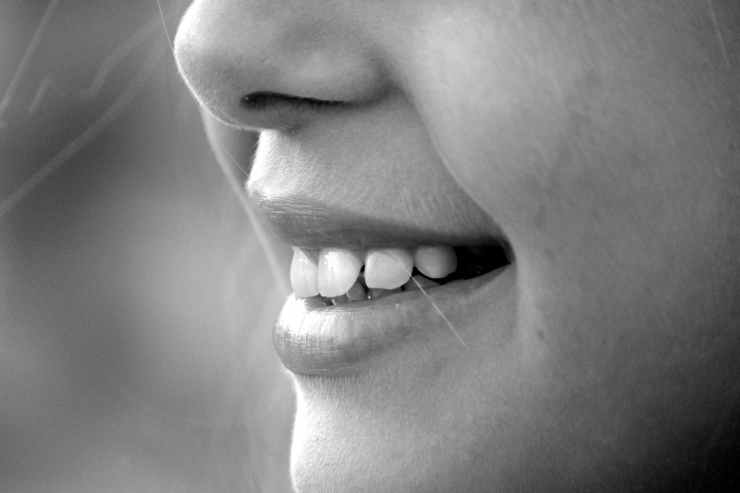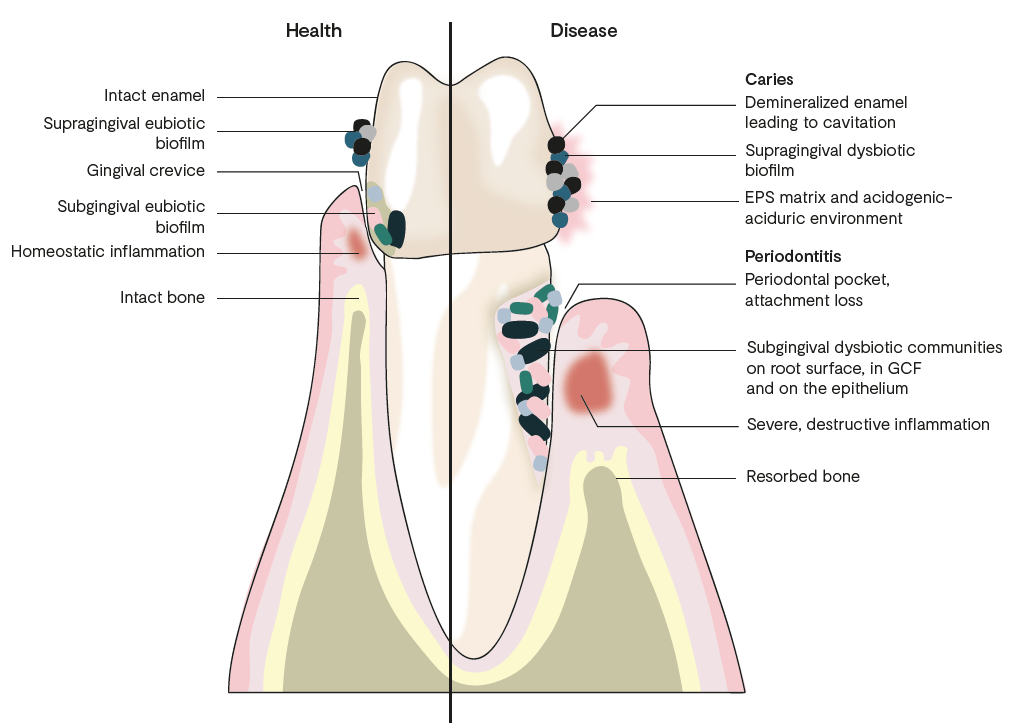
First, we will consider how to test for issues affecting the mouth and then, further down, I will talk about treatment.
Bacterial Mouth Test
We have been very good over the past couple of decades at looking for infections and problems in the gut that can trigger or are linked to inflammatory and autoimmune disorders elsewhere in the body. But I’ve always felt we were missing a trick by not considering infections and inflammation at the other end of the digestive tract: the mouth.
I used to do a dental test from Germany but then I wasn’t able to get it. Now, I am pleased to report the Oral Ecologix test has come along instead. This test looks for levels of ‘good’ and ‘bad’ bacteria. It’s done using PCR and ELISA testing on a 2ml saliva sample. You can see all Infection tests here.
Leaky gums – leaky gut – leaky brain!
So, why is it important to test the mouth as well as the gut? Because the problem might not be in the gut, but at the other end!
Essentially, periodontal pockets cause a ‘leaky’ mouth and any pathogenic bacteria present can gain access through ulcerated and inflamed tissues to trigger non-oral problems. Much like gut bacteria and LPSs can do via a leaky gut. Same process. Also chronic inflammation in the mouth can be a trigger for other inflammatory disorders in the body. For example, in my recent brain work, one of the things to look for is infection in the mouth or gut which could hit the brain either via the vagus nerve or via leaky mucosal barriers – ie. could infection endotoxins entering the system through a leaky gut or leaky mouth be causing a leaky and inflamed brain, thus increasing risk of brain disorders like dementias and Alzheimer’s? Quite possibly.
I wonder too that if the mouth is leaky, could that not logically be an entry point for food intolerance reactions to trigger long before the food gets to the gut? I bet it is. So, checking and correcting the oral microbiome (the balance of bacteria) in the mouth as well as the gut could be key for chronic multiple sensitivity.
Here is some info on which disorders in the body oral microbiome problems might play a role:
SYSTEMIC DISORDERS
There is a growing body of research to support a role for PD [periodontal] pathogens as contributing factors for numerous systemic diseases, including cardiovascular disease (CVD), diabetes, adverse pregnancy outcomes, rheumatoid arthritis (RA) and Alzheimer’s disease (AD)29–33. The proposed aetiology involves direct and indirect effects of oral bacteria on host immune responses, inflammation and therefore development of systemic disorders.
1. Direct mechanism: In chronic periodontitis, periodontal pockets become ulcerated providing direct entry points for oral bacteria into the systemic circulation. Circulating bacteria (i.e. P. gingivalis; T. forsynthia) may then induce direct effects on organs and tissues. [As we’ve said above]
2. Indirect mechanism: Chronic inflammation has been implicated in a multitude of disorders including diabetes, obesity and autoimmune disorders. Chronic inflammation associated with chronic periodontitis may represent a source of inflammation able to induce and acerbate systemic disorders.
PregnancyF. nucleatum is the most prevalent oral species implicated in adverse pregnancy outcomes (i.e. miscarriage, preterm labour) 34. C. rectus is also associated with adverse pregnancy outcomes, including preterm delivery 37.
CardiovascularS. mutans is associated with bacteraemia and infective endocarditis (IE)38.
NeurodegenerationPeriodontal pathogens, P. gingivalis and T. denticola are also associated with the development of Alzheimer’s disease (AD)45. LPS of P. gingivalis was detected in the brain tissue of AD patients 46. In addition, in a recent study using a mouse model for
periodontitis, after infection a significant number of P. gingivalis genomic DNA was detected in the brain 47.
ArthritisP. gingivalis has also been implicated in the pathogenesis of rheumatoid arthritis (RA)…. Furthermore, significantly higher anti-P. gingivalis antibodies have been
detected in patients with RA, compared to systemically and periodontally-healthy controls 48.IBD
Fusobacterium nucleatum has been linked to colorectal cancer (CRC). It is found in high amounts in CRC carcinomas, adenomas, in stools of patients with carcinoma and in rectal swabs of CRC patients49,50. This bacterium has also been detected in colonic biopsies of IBD patients 51, and strains isolated from inflamed tissues of IBD patients are more virulent than those from healthy individuals 52.
That’s quite shocking isn’t it?
So, my advice might be if you suffer with any autoimmune or inflammatory condition, or maybe are having repeated pregnancy problems, don’t just look at the gut for infection triggers, look also in the mouth!
You can see the new Oral Ecologix test here (in the Infection Tests section). Here is a sample report for you so you can see what’s covered.
For now, here is some blurb on the test for you:
The oral cavity is a complex ecosystem, comprising several habitats including the teeth, gums, tongue and tonsils, all colonised by bacteria. The oral microbiota is comprised of approximately 600 taxa at the species level, with different groups and subsets inhabiting different niches.
The microbiota of the oral cavity exists as a complex biofilm that remains stable despite environmental changes. However, dysbiosis, in form of infection, injury, dietary changes and risk-associated factors (e.g. smoking) may disrupt the biofilm community, favouring colonisation and invasion of pathogens. Disruption of the biofilm community to a pathogenic profile induces host immune responses, chronic inflammation and ultimately the development of local and systemic diseases.
Much of this damage is reversible if pathogenic communities are removed, and homeostasis is restored; therefore, analysis and monitoring of the oral microbiota is important for health and can be used to inform treatment plans and lifestyle factors.
Figure 1: Development of disease in the oral cavity. Figure adapted from Lamont et al. (2018). For microbiota composition analysis, the technology detects:
- Abundance of commensal bacteria
- Abundance of caries-associated bacteria
- Abundance of periodontitis-associated bacteria (orange and red-complex bacteria/pathogens)
- Presence of candida albicans
You can see the new Oral Ecologix test here (in the Infection Tests section). Here is a sample report for you so you can see what’s covered.
Mouth and Gum Treatment
If you find you have a problem, what do you do about it? Well, it depends what it is, but essentially I would advise a specialist oral probiotic, an oral complex and a toxin-absorbing toothpaste like this.
Homeopathy has a good pedigree for dental pain and problems too. My colleague, Karen, gives us a rundown of the top 12 here.
Dental First Aid with Homeopathy – Twelve Remedies
I have also been looking into Ozone Therapy for Dentistry, which seems to offer a lot of help for infections etc and is much more gentle than a lot of other approaches. You can read about that here:
Ozone gas: reversing tooth decay
Here, too, is a useful essential oil Tooth & Gum Rub:
Put 10 drops of each of the following into 100ml bottle of olive or other oil you can tolerate: Peppermint, Cajeput, Clove, Frankincense and Myrrh. Mix it well before using. Put one drop on a clean fingertip and massage all around your gums. This should help with infections and to strengthen them. You can get good essential oils here.
Please support Purehealth
If buying supplements mentioned in this article through Natural Dispensary, please use Micki Rose during registration when prompted. If using Amrita, use this code to register for access to advanced products, no need to do it again then: 4Y2AE7. For tests – please see the test pages here . Using these links and codes gives me a bit of commission, which helps keep me going. Bless your cotton socks for helping x. If I’ve helped, you can buy me a coffee here. And you can get 1:1 support here.
